Homeostasis: Regulation of Blood Sugar and the Digestive System
VerifiedAdded on 2023/02/01
|7
|1374
|53
Essay
AI Summary
This essay provides an overview of homeostasis, the body's mechanism for maintaining a stable internal environment. It details the roles of the nervous and endocrine systems in detecting and responding to environmental changes, with a focus on negative feedback loops. The essay specifically examines the digestive system, highlighting the liver's function in glucose storage and the pancreas's role in insulin and glucagon production for blood sugar regulation. It uses the example of liver cirrhosis to illustrate the disruption of homeostasis and its effects on blood sugar levels and lipid digestion. The essay further explains the roles of insulin and glucagon in maintaining blood sugar homeostasis and how disruptions in these processes can lead to diabetes. A concept map summarizes the glucose level homeostasis process. Desklib offers a wealth of similar solved assignments and study resources for students.
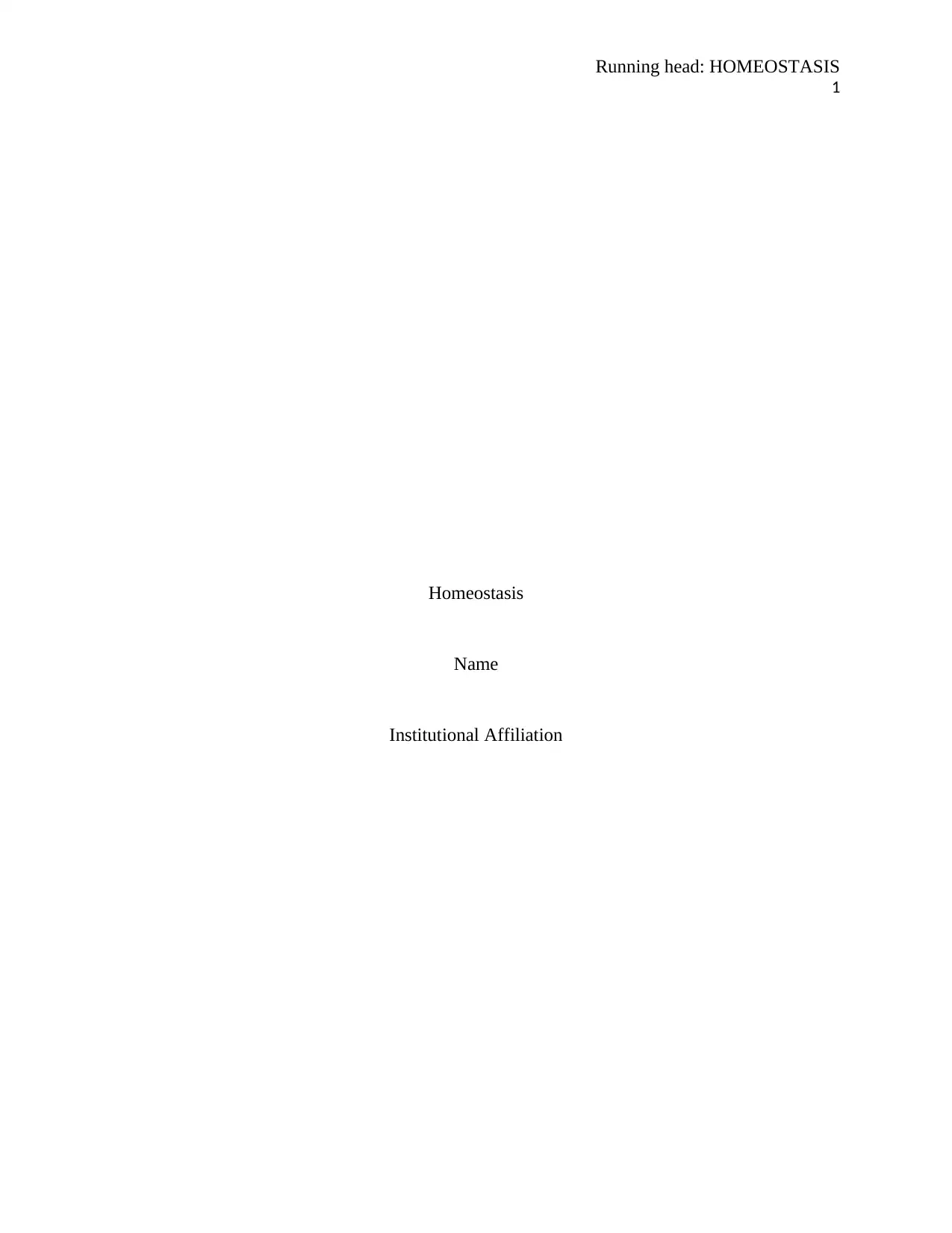
Running head: HOMEOSTASIS
1
Homeostasis
Name
Institutional Affiliation
1
Homeostasis
Name
Institutional Affiliation
Paraphrase This Document
Need a fresh take? Get an instant paraphrase of this document with our AI Paraphraser
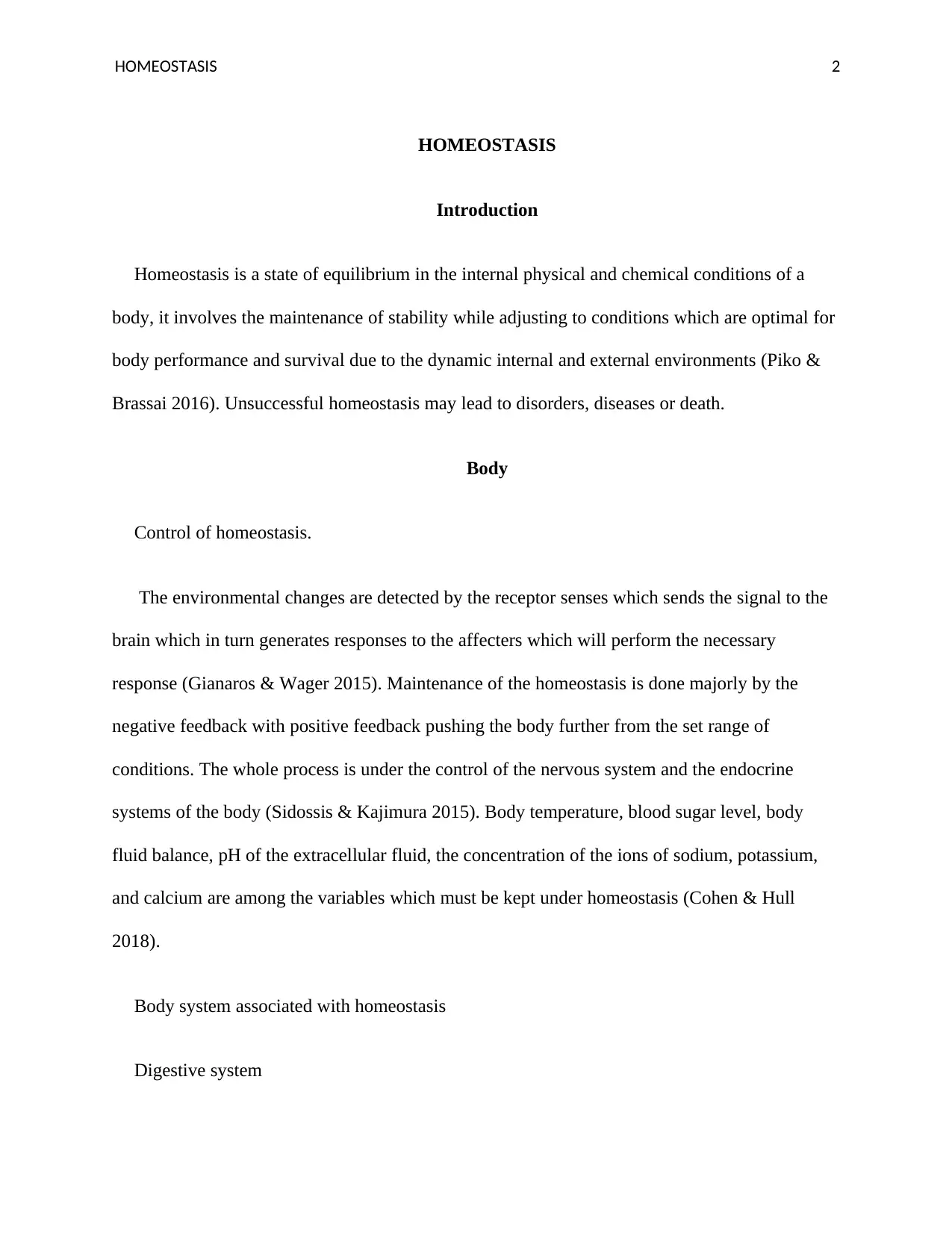
HOMEOSTASIS 2
HOMEOSTASIS
Introduction
Homeostasis is a state of equilibrium in the internal physical and chemical conditions of a
body, it involves the maintenance of stability while adjusting to conditions which are optimal for
body performance and survival due to the dynamic internal and external environments (Piko &
Brassai 2016). Unsuccessful homeostasis may lead to disorders, diseases or death.
Body
Control of homeostasis.
The environmental changes are detected by the receptor senses which sends the signal to the
brain which in turn generates responses to the affecters which will perform the necessary
response (Gianaros & Wager 2015). Maintenance of the homeostasis is done majorly by the
negative feedback with positive feedback pushing the body further from the set range of
conditions. The whole process is under the control of the nervous system and the endocrine
systems of the body (Sidossis & Kajimura 2015). Body temperature, blood sugar level, body
fluid balance, pH of the extracellular fluid, the concentration of the ions of sodium, potassium,
and calcium are among the variables which must be kept under homeostasis (Cohen & Hull
2018).
Body system associated with homeostasis
Digestive system
HOMEOSTASIS
Introduction
Homeostasis is a state of equilibrium in the internal physical and chemical conditions of a
body, it involves the maintenance of stability while adjusting to conditions which are optimal for
body performance and survival due to the dynamic internal and external environments (Piko &
Brassai 2016). Unsuccessful homeostasis may lead to disorders, diseases or death.
Body
Control of homeostasis.
The environmental changes are detected by the receptor senses which sends the signal to the
brain which in turn generates responses to the affecters which will perform the necessary
response (Gianaros & Wager 2015). Maintenance of the homeostasis is done majorly by the
negative feedback with positive feedback pushing the body further from the set range of
conditions. The whole process is under the control of the nervous system and the endocrine
systems of the body (Sidossis & Kajimura 2015). Body temperature, blood sugar level, body
fluid balance, pH of the extracellular fluid, the concentration of the ions of sodium, potassium,
and calcium are among the variables which must be kept under homeostasis (Cohen & Hull
2018).
Body system associated with homeostasis
Digestive system
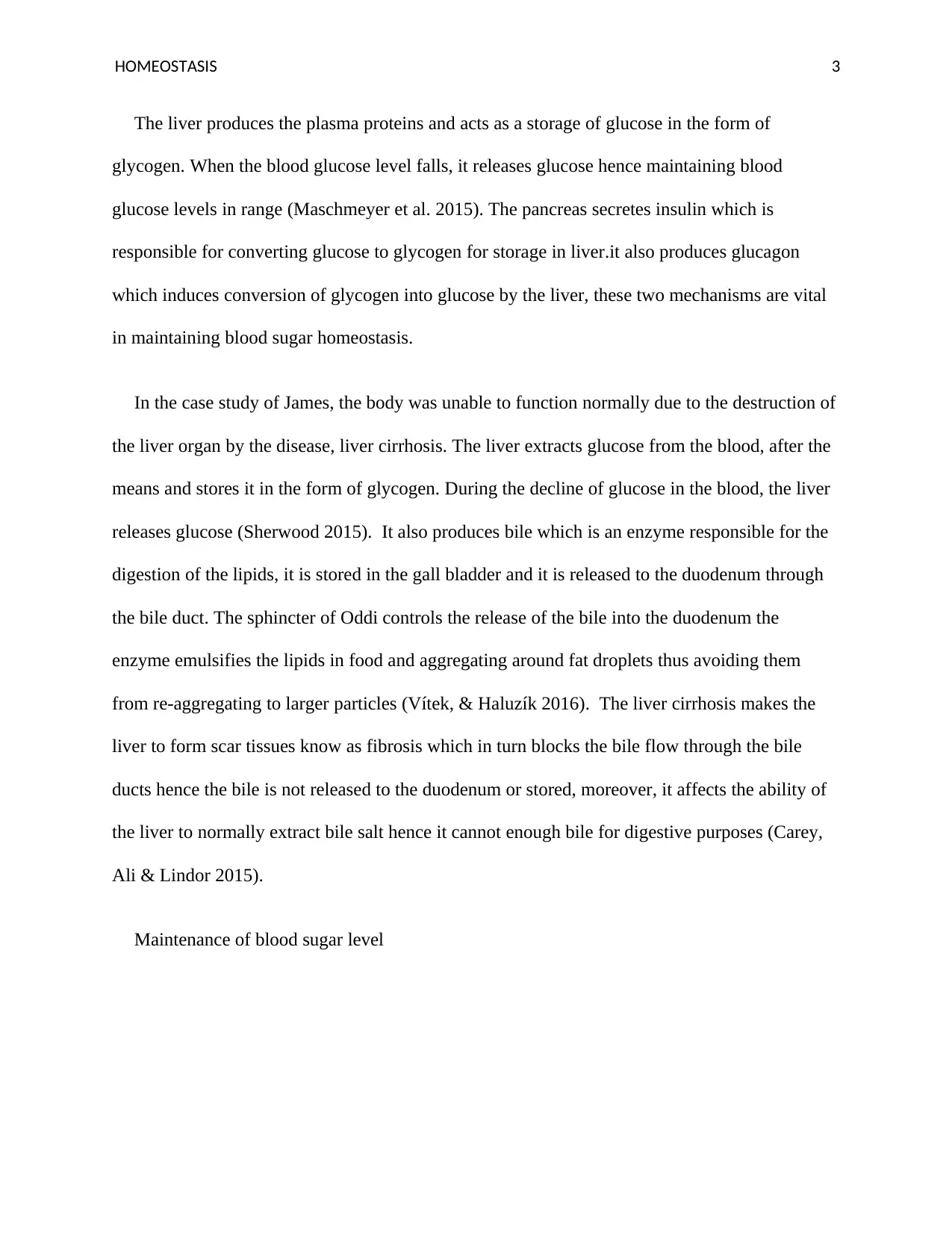
HOMEOSTASIS 3
The liver produces the plasma proteins and acts as a storage of glucose in the form of
glycogen. When the blood glucose level falls, it releases glucose hence maintaining blood
glucose levels in range (Maschmeyer et al. 2015). The pancreas secretes insulin which is
responsible for converting glucose to glycogen for storage in liver.it also produces glucagon
which induces conversion of glycogen into glucose by the liver, these two mechanisms are vital
in maintaining blood sugar homeostasis.
In the case study of James, the body was unable to function normally due to the destruction of
the liver organ by the disease, liver cirrhosis. The liver extracts glucose from the blood, after the
means and stores it in the form of glycogen. During the decline of glucose in the blood, the liver
releases glucose (Sherwood 2015). It also produces bile which is an enzyme responsible for the
digestion of the lipids, it is stored in the gall bladder and it is released to the duodenum through
the bile duct. The sphincter of Oddi controls the release of the bile into the duodenum the
enzyme emulsifies the lipids in food and aggregating around fat droplets thus avoiding them
from re-aggregating to larger particles (Vítek, & Haluzík 2016). The liver cirrhosis makes the
liver to form scar tissues know as fibrosis which in turn blocks the bile flow through the bile
ducts hence the bile is not released to the duodenum or stored, moreover, it affects the ability of
the liver to normally extract bile salt hence it cannot enough bile for digestive purposes (Carey,
Ali & Lindor 2015).
Maintenance of blood sugar level
The liver produces the plasma proteins and acts as a storage of glucose in the form of
glycogen. When the blood glucose level falls, it releases glucose hence maintaining blood
glucose levels in range (Maschmeyer et al. 2015). The pancreas secretes insulin which is
responsible for converting glucose to glycogen for storage in liver.it also produces glucagon
which induces conversion of glycogen into glucose by the liver, these two mechanisms are vital
in maintaining blood sugar homeostasis.
In the case study of James, the body was unable to function normally due to the destruction of
the liver organ by the disease, liver cirrhosis. The liver extracts glucose from the blood, after the
means and stores it in the form of glycogen. During the decline of glucose in the blood, the liver
releases glucose (Sherwood 2015). It also produces bile which is an enzyme responsible for the
digestion of the lipids, it is stored in the gall bladder and it is released to the duodenum through
the bile duct. The sphincter of Oddi controls the release of the bile into the duodenum the
enzyme emulsifies the lipids in food and aggregating around fat droplets thus avoiding them
from re-aggregating to larger particles (Vítek, & Haluzík 2016). The liver cirrhosis makes the
liver to form scar tissues know as fibrosis which in turn blocks the bile flow through the bile
ducts hence the bile is not released to the duodenum or stored, moreover, it affects the ability of
the liver to normally extract bile salt hence it cannot enough bile for digestive purposes (Carey,
Ali & Lindor 2015).
Maintenance of blood sugar level
⊘ This is a preview!⊘
Do you want full access?
Subscribe today to unlock all pages.

Trusted by 1+ million students worldwide
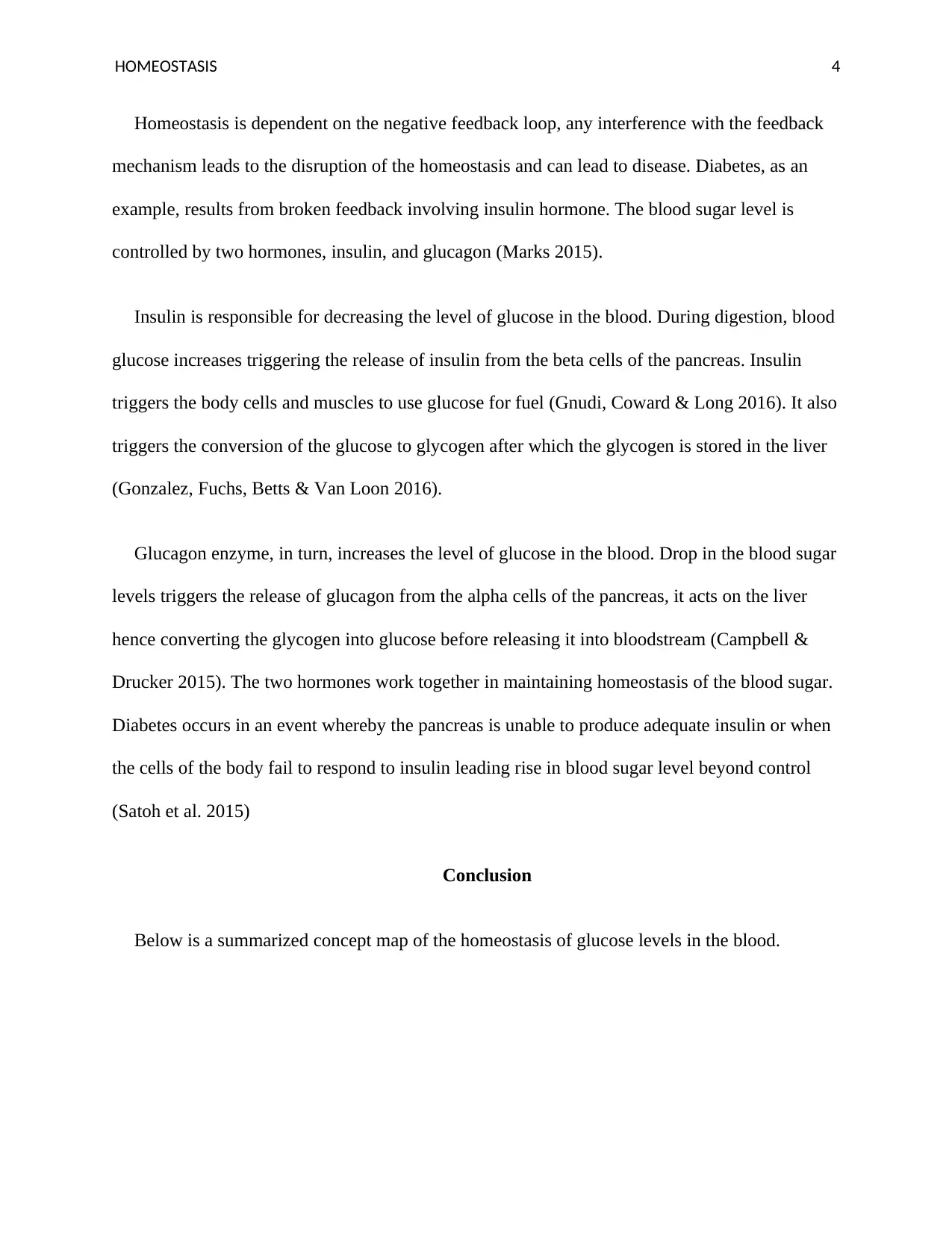
HOMEOSTASIS 4
Homeostasis is dependent on the negative feedback loop, any interference with the feedback
mechanism leads to the disruption of the homeostasis and can lead to disease. Diabetes, as an
example, results from broken feedback involving insulin hormone. The blood sugar level is
controlled by two hormones, insulin, and glucagon (Marks 2015).
Insulin is responsible for decreasing the level of glucose in the blood. During digestion, blood
glucose increases triggering the release of insulin from the beta cells of the pancreas. Insulin
triggers the body cells and muscles to use glucose for fuel (Gnudi, Coward & Long 2016). It also
triggers the conversion of the glucose to glycogen after which the glycogen is stored in the liver
(Gonzalez, Fuchs, Betts & Van Loon 2016).
Glucagon enzyme, in turn, increases the level of glucose in the blood. Drop in the blood sugar
levels triggers the release of glucagon from the alpha cells of the pancreas, it acts on the liver
hence converting the glycogen into glucose before releasing it into bloodstream (Campbell &
Drucker 2015). The two hormones work together in maintaining homeostasis of the blood sugar.
Diabetes occurs in an event whereby the pancreas is unable to produce adequate insulin or when
the cells of the body fail to respond to insulin leading rise in blood sugar level beyond control
(Satoh et al. 2015)
Conclusion
Below is a summarized concept map of the homeostasis of glucose levels in the blood.
Homeostasis is dependent on the negative feedback loop, any interference with the feedback
mechanism leads to the disruption of the homeostasis and can lead to disease. Diabetes, as an
example, results from broken feedback involving insulin hormone. The blood sugar level is
controlled by two hormones, insulin, and glucagon (Marks 2015).
Insulin is responsible for decreasing the level of glucose in the blood. During digestion, blood
glucose increases triggering the release of insulin from the beta cells of the pancreas. Insulin
triggers the body cells and muscles to use glucose for fuel (Gnudi, Coward & Long 2016). It also
triggers the conversion of the glucose to glycogen after which the glycogen is stored in the liver
(Gonzalez, Fuchs, Betts & Van Loon 2016).
Glucagon enzyme, in turn, increases the level of glucose in the blood. Drop in the blood sugar
levels triggers the release of glucagon from the alpha cells of the pancreas, it acts on the liver
hence converting the glycogen into glucose before releasing it into bloodstream (Campbell &
Drucker 2015). The two hormones work together in maintaining homeostasis of the blood sugar.
Diabetes occurs in an event whereby the pancreas is unable to produce adequate insulin or when
the cells of the body fail to respond to insulin leading rise in blood sugar level beyond control
(Satoh et al. 2015)
Conclusion
Below is a summarized concept map of the homeostasis of glucose levels in the blood.
Paraphrase This Document
Need a fresh take? Get an instant paraphrase of this document with our AI Paraphraser
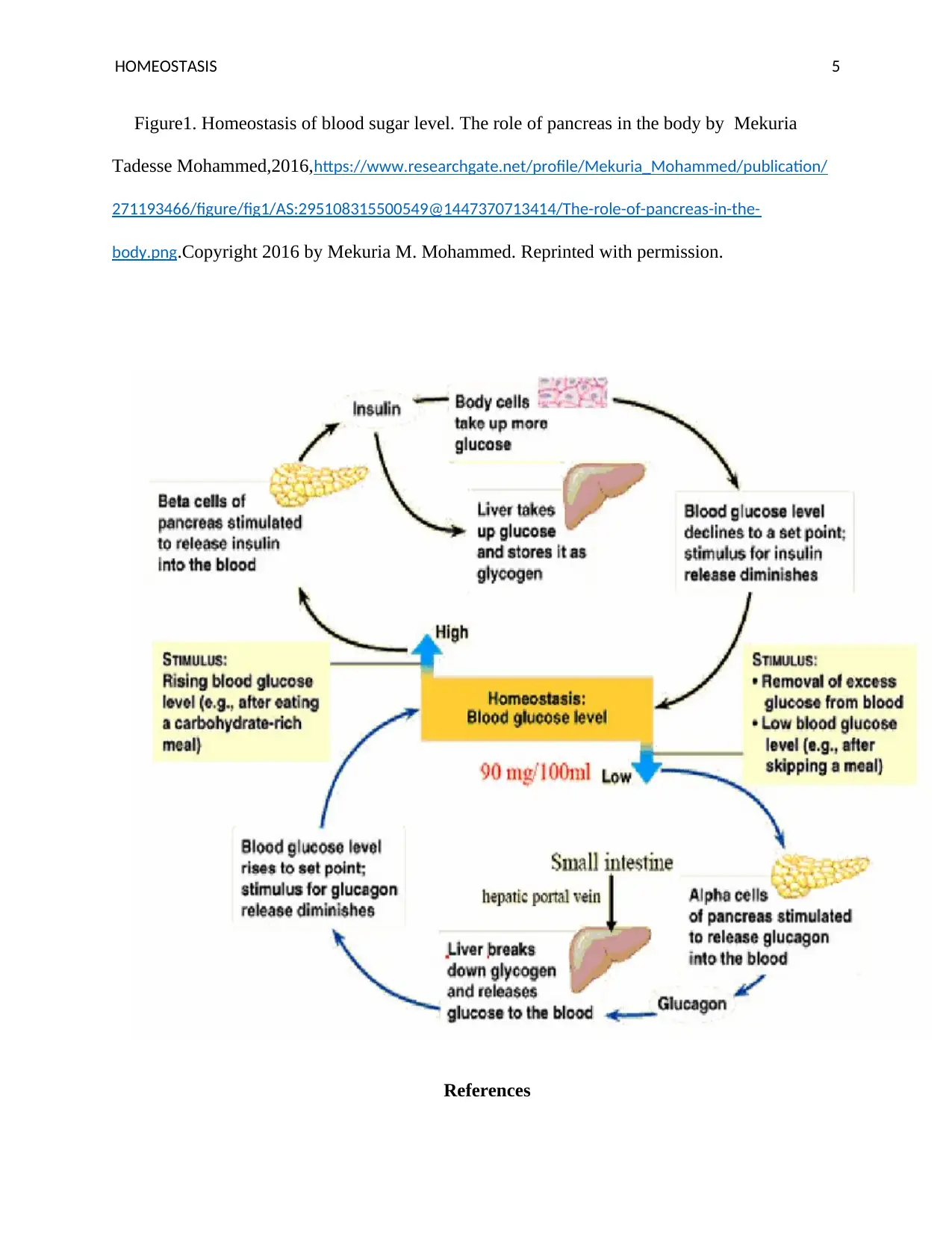
HOMEOSTASIS 5
Figure1. Homeostasis of blood sugar level. The role of pancreas in the body by Mekuria
Tadesse Mohammed,2016,https://www.researchgate.net/profile/Mekuria_Mohammed/publication/
271193466/figure/fig1/AS:295108315500549@1447370713414/The-role-of-pancreas-in-the-
body.png.Copyright 2016 by Mekuria M. Mohammed. Reprinted with permission.
References
Figure1. Homeostasis of blood sugar level. The role of pancreas in the body by Mekuria
Tadesse Mohammed,2016,https://www.researchgate.net/profile/Mekuria_Mohammed/publication/
271193466/figure/fig1/AS:295108315500549@1447370713414/The-role-of-pancreas-in-the-
body.png.Copyright 2016 by Mekuria M. Mohammed. Reprinted with permission.
References
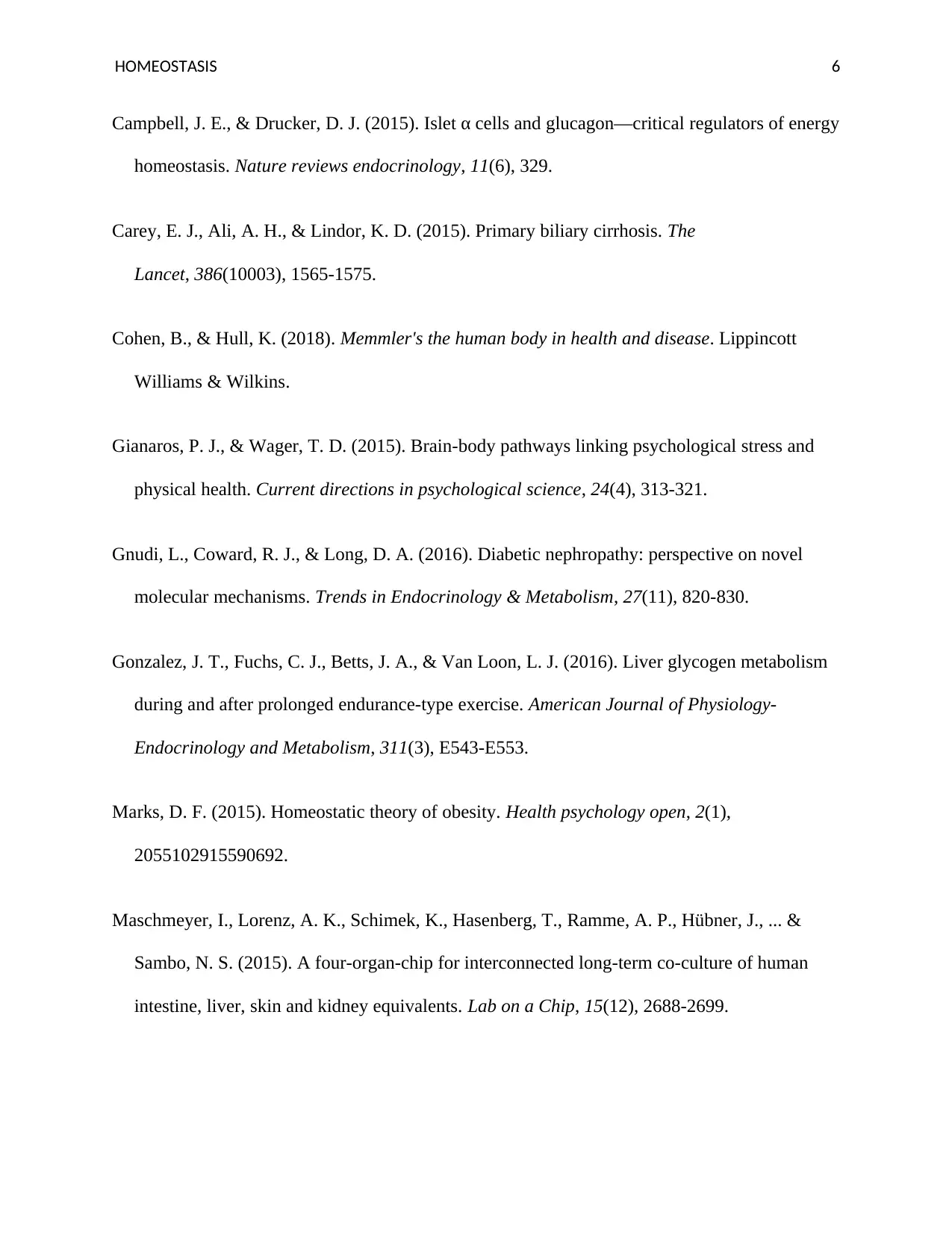
HOMEOSTASIS 6
Campbell, J. E., & Drucker, D. J. (2015). Islet α cells and glucagon—critical regulators of energy
homeostasis. Nature reviews endocrinology, 11(6), 329.
Carey, E. J., Ali, A. H., & Lindor, K. D. (2015). Primary biliary cirrhosis. The
Lancet, 386(10003), 1565-1575.
Cohen, B., & Hull, K. (2018). Memmler's the human body in health and disease. Lippincott
Williams & Wilkins.
Gianaros, P. J., & Wager, T. D. (2015). Brain-body pathways linking psychological stress and
physical health. Current directions in psychological science, 24(4), 313-321.
Gnudi, L., Coward, R. J., & Long, D. A. (2016). Diabetic nephropathy: perspective on novel
molecular mechanisms. Trends in Endocrinology & Metabolism, 27(11), 820-830.
Gonzalez, J. T., Fuchs, C. J., Betts, J. A., & Van Loon, L. J. (2016). Liver glycogen metabolism
during and after prolonged endurance-type exercise. American Journal of Physiology-
Endocrinology and Metabolism, 311(3), E543-E553.
Marks, D. F. (2015). Homeostatic theory of obesity. Health psychology open, 2(1),
2055102915590692.
Maschmeyer, I., Lorenz, A. K., Schimek, K., Hasenberg, T., Ramme, A. P., Hübner, J., ... &
Sambo, N. S. (2015). A four-organ-chip for interconnected long-term co-culture of human
intestine, liver, skin and kidney equivalents. Lab on a Chip, 15(12), 2688-2699.
Campbell, J. E., & Drucker, D. J. (2015). Islet α cells and glucagon—critical regulators of energy
homeostasis. Nature reviews endocrinology, 11(6), 329.
Carey, E. J., Ali, A. H., & Lindor, K. D. (2015). Primary biliary cirrhosis. The
Lancet, 386(10003), 1565-1575.
Cohen, B., & Hull, K. (2018). Memmler's the human body in health and disease. Lippincott
Williams & Wilkins.
Gianaros, P. J., & Wager, T. D. (2015). Brain-body pathways linking psychological stress and
physical health. Current directions in psychological science, 24(4), 313-321.
Gnudi, L., Coward, R. J., & Long, D. A. (2016). Diabetic nephropathy: perspective on novel
molecular mechanisms. Trends in Endocrinology & Metabolism, 27(11), 820-830.
Gonzalez, J. T., Fuchs, C. J., Betts, J. A., & Van Loon, L. J. (2016). Liver glycogen metabolism
during and after prolonged endurance-type exercise. American Journal of Physiology-
Endocrinology and Metabolism, 311(3), E543-E553.
Marks, D. F. (2015). Homeostatic theory of obesity. Health psychology open, 2(1),
2055102915590692.
Maschmeyer, I., Lorenz, A. K., Schimek, K., Hasenberg, T., Ramme, A. P., Hübner, J., ... &
Sambo, N. S. (2015). A four-organ-chip for interconnected long-term co-culture of human
intestine, liver, skin and kidney equivalents. Lab on a Chip, 15(12), 2688-2699.
⊘ This is a preview!⊘
Do you want full access?
Subscribe today to unlock all pages.

Trusted by 1+ million students worldwide
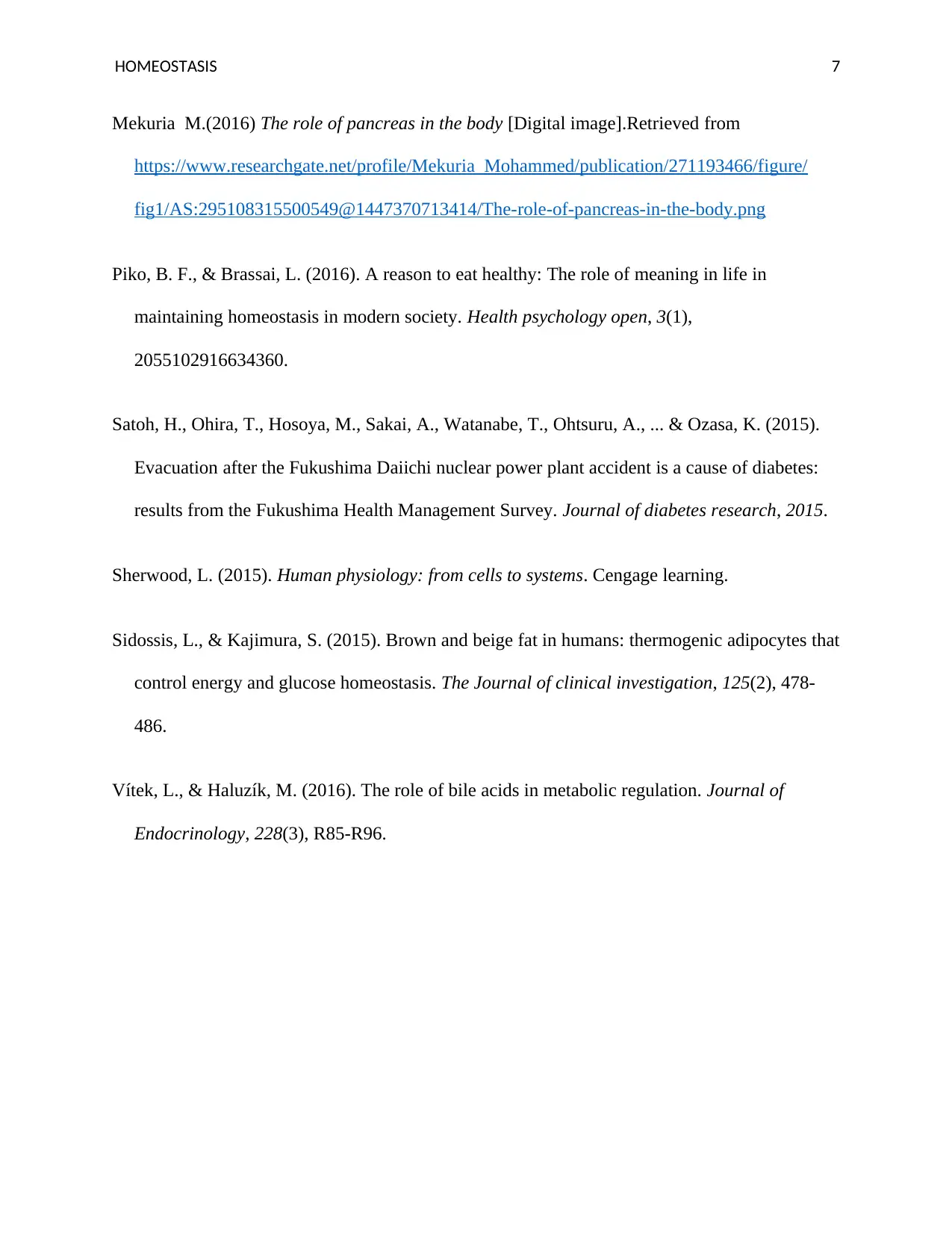
HOMEOSTASIS 7
Mekuria M.(2016) The role of pancreas in the body [Digital image].Retrieved from
https://www.researchgate.net/profile/Mekuria_Mohammed/publication/271193466/figure/
fig1/AS:295108315500549@1447370713414/The-role-of-pancreas-in-the-body.png
Piko, B. F., & Brassai, L. (2016). A reason to eat healthy: The role of meaning in life in
maintaining homeostasis in modern society. Health psychology open, 3(1),
2055102916634360.
Satoh, H., Ohira, T., Hosoya, M., Sakai, A., Watanabe, T., Ohtsuru, A., ... & Ozasa, K. (2015).
Evacuation after the Fukushima Daiichi nuclear power plant accident is a cause of diabetes:
results from the Fukushima Health Management Survey. Journal of diabetes research, 2015.
Sherwood, L. (2015). Human physiology: from cells to systems. Cengage learning.
Sidossis, L., & Kajimura, S. (2015). Brown and beige fat in humans: thermogenic adipocytes that
control energy and glucose homeostasis. The Journal of clinical investigation, 125(2), 478-
486.
Vítek, L., & Haluzík, M. (2016). The role of bile acids in metabolic regulation. Journal of
Endocrinology, 228(3), R85-R96.
Mekuria M.(2016) The role of pancreas in the body [Digital image].Retrieved from
https://www.researchgate.net/profile/Mekuria_Mohammed/publication/271193466/figure/
fig1/AS:295108315500549@1447370713414/The-role-of-pancreas-in-the-body.png
Piko, B. F., & Brassai, L. (2016). A reason to eat healthy: The role of meaning in life in
maintaining homeostasis in modern society. Health psychology open, 3(1),
2055102916634360.
Satoh, H., Ohira, T., Hosoya, M., Sakai, A., Watanabe, T., Ohtsuru, A., ... & Ozasa, K. (2015).
Evacuation after the Fukushima Daiichi nuclear power plant accident is a cause of diabetes:
results from the Fukushima Health Management Survey. Journal of diabetes research, 2015.
Sherwood, L. (2015). Human physiology: from cells to systems. Cengage learning.
Sidossis, L., & Kajimura, S. (2015). Brown and beige fat in humans: thermogenic adipocytes that
control energy and glucose homeostasis. The Journal of clinical investigation, 125(2), 478-
486.
Vítek, L., & Haluzík, M. (2016). The role of bile acids in metabolic regulation. Journal of
Endocrinology, 228(3), R85-R96.
1 out of 7
Related Documents
Your All-in-One AI-Powered Toolkit for Academic Success.
+13062052269
info@desklib.com
Available 24*7 on WhatsApp / Email
![[object Object]](/_next/static/media/star-bottom.7253800d.svg)
Unlock your academic potential
Copyright © 2020–2025 A2Z Services. All Rights Reserved. Developed and managed by ZUCOL.





